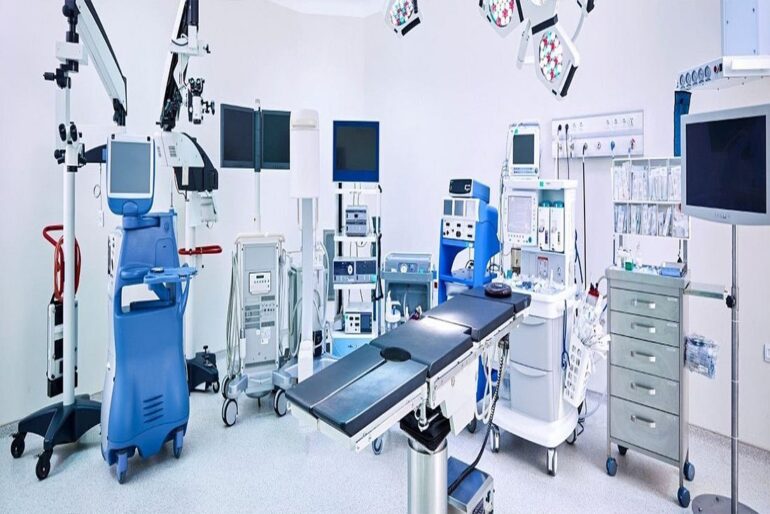🔴 Website 👉 https://u-s-news.com/
Telegram 👉 https://t.me/usnewscom_channel
My print interview with bioethicist Charlie Camosy on how modern medicine lost focus on the health of the patient.
The following interview with Charlie Camosy recently appeared in OSV News and republished here with permission.
Has modern medicine lost its focus on the health of the patient? That’s the contention of Aaron Kheriaty, a physician specializing in psychiatry who serves as director of the Bioethics, Technology, and Human Flourishing Program at the Ethics and Public Policy Center. He spoke with OSV News’Charles Camosy about the flawed vision of patient care pervasive in modern medicine in his new book Making the Cut: How to heal modern medicine.
Charles Camosy: Your story permeates this book. Can you give us a preview or brief overview of how you came to write a book like this?
Aaron Kheriaty: The narrative portions of Making the Cut: How to Heal Modern Medicine, which recount my four years at Georgetown University School of Medicine, were written 22 years ago, immediately upon completion of medical school.
This gives them an immediacy that would not have been possible had I written those sections today, when many of the details of these cases have since faded from memory.
Here’s a taste of the narrative, from the opening of Chapter 5, which gives you a flavour of the gritty realism that places the reader at the hospital operating room or the clinic bedside:
“My job was to hold the leg. Until I was holding just the leg. The electric saw was buzzing, bits of bone were flying, and a tendril of smoke wafted up from the point where saw met bone. We were performing an amputation. It was a surprisingly quick operation, no more than half an hour. Above the knee, the resident made a circumferential cut with a scalpel, tied off the few major leg vessels, and continued cutting until he reached bone.
“Then it was time to pick up the saw, an instrument that did its work quickly . . . until the leg came off in my hands, floating free from the patient’s body. It was heavier than I expected. I handed it to a nurse, who put it in a plastic bag marked ‘biohazard’ and carried it out of the operating room. I wondered what they did with these biohazards.”
The more mature philosophy of medicine, the critique of contemporary health care, and my proposed solutions for reforming medicine were parts of the book I wrote more recently, after 20 years of clinical practice.
So, the book has been a couple decades in the making. Hopefully that additional experience as a physician informs my thoughts and reflections on the narrative stories I recount from training.
Camosy: If you had to boil down the central problem with the way we practice health care in the US, how would you do that?
Kheriaty: Somewhere along the way, medicine itself got sick. A recent survey of almost half a million Americans published in the Journal of the American Medical Association showed that trust in physicians and hospitals plummeted 30 points following the COVID crisis, from 72 percent to 40 percent.
Meanwhile, we’re grappling with an epidemic of chronic illness – heart disease, cancer, diabetes, obesity, metabolic syndrome, Alzheimer’s, stroke, and chronic lung and kidney disease – affecting six in ten Americans, which medicine seems powerless to fix.
Starting in 2014, the overall life expectancy of Americans has declined for the first time since the 1918 influenza pandemic.
The United States spends twice as much on health care per capita than any other country but barely ranks in the top 50 in terms of health outcomes.
As I argue in the book, like the old Soviet Union, the US health care system has evolved so that a whole bunch of vested interests can extract rents from a bloated, dysfunctional bureaucracy. And patients are left to suffer.
Sad to say, the highest aim of modern medicine is not health, but rather efficiency. Today, medicine has often become more adept at controlling bodies than curing them.
Like other fields, it has fatally succumbed to managerialism – the belief that, through the accumulation of “rational” knowledge, everything can and should be engineered and managed from the top down.
It matters little whether the management is coming from government bureaucrats or corporate conglomerates.
Managerialism ignores the fact that every patient is unique. No sick person wants to be “processed” through an industrial-scale, “turnstile” medical system that treats every patient exactly the same.
This starts with medical training, where students are conditioned, beginning in gross anatomy lab in the first year, to view the human body as nothing more than a complex machine, an assemblage of replaceable parts.
Camosy: I’m very interested in how the Catholic Church can move to address this central problem. Through its massive health care systems, yes, but also how it trains those who practice health care. Any thoughts on this?
Kheriaty: We need to recover a sound Christian anthropology, rooted in the Catholic intellectual tradition, to correct the errors of modern scientism – which is the (non-scientific) claim that science is the only valid form of knowledge.
This leads to a crass materialism, whereby the living body comes to be seen as a machine – as dead matter somehow kept in motion by mysterious forces we don’t understand.
Consider, for example, this dubious claim from a contemporary textbook of medical physiology: “The human being is actually an automaton, and the fact that we are sensing, feeling, and knowledgeable beings is part of this automatic sequence of life.”
This reductionist view of the living body as a mere dead mechanism is not new. We find the roots of this cramped attitude in the advent of modern medical science, including physiology, which is supposed to study the dynamic processes of life.
The dead/mechanistic model continues to ail medicine to this day.
Contrary to this mechanistic picture, biological life is an intricately choreographed dance that cannot be captured in a photograph.
The machine model of the human body persists in our imagination not because it is true, but because “it encourages the sense that we can easily understand what life is and learn to control it” – a tempting proposition for our Faustian age.
We need a new medicine, attentive not just to decontextualised mechanistic forces – controlling blind biological functions without purpose – but attentive to meanings, intentions, loves, hopes, fears and embodied purposes.
That is to say, we need a medicine that treats human life as always embedded within a community and a context of meaning.
The rich tradition of the Catholic Church’s understanding of what it means to be human is the best remedy to these serious deficiencies in modern medicine’s view of human life.
Camosy: Do you have advice for faithful Catholics who are navigating our current health care system with your concerns in mind?
Kheriaty: Remember that your conscience rights to recuse yourselves from immoral procedures are protected in federal law, and the HHS Office of Civil Rights as well as the lawyers at the Alliance Defending Freedom can assist if your training program attempts to force you to participate in abortions, sterilisation procedures, euthanasia or anything else that contradicts the healing goals of medicine.
It takes courage to navigate those tough situations; but do not be afraid to stand up for your rights and defend the value of human life at all stages, from conception to natural death. This courage and prudence will require a life of prayer and the grace of the sacraments.
As Our Lord instructed us, we should seek first God’s kingdom, and everything else will be given to us besides.
Trust in his providence, and do not fear suffering or hardship. Jesus made it clear: We cannot follow him unless we deny ourselves and take up our cross daily.
It’s precisely in the cross of Christ that we find freedom and peace.
Charles Camosy teaches moral theology and bioethics at The Catholic University of America in Washington.
Human Flourishing is a reader-supported publication. To receive new posts and support my work, consider becoming a free or paid subscriber.
This content is courtesy of, and owned and copyrighted by, https://peckford42.wordpress.com and its author. This content is made available by use of the public RSS feed offered by the host site and is used for educational purposes only. If you are the author or represent the host site and would like this content removed now and in the future, please contact USSANews.com using the email address in the Contact page found in the website menu.

